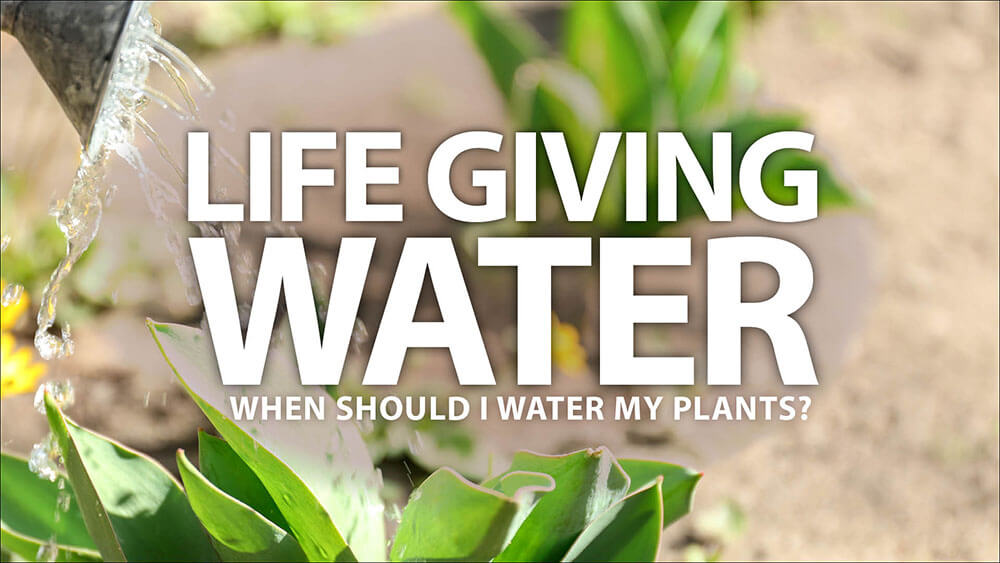When should I water my plants?
The number one question we get asked here at the nursery is when should I water my plants? That’s simple; water them when they need it! Unfortunately it’s not like following a recipe where you add X amount of water every Y number of days. There are many variables involved such as humidity, temperature, light, type of plant and even the time of year.
The single most important thing to remember is that plant roots need to breathe just like we do. They need water but they also need oxygen. That is why the soil needs to dry out between watering, so the roots can obtain oxygen. It is easier for a plant to recover from not enough water than it is for them to recover from repeated over watering. Plants that sit in too much water for a prolonged period will suffer from root rot and that’s usually a death sentence. The more optimal conditions you can provide for a plant, the faster it will grow. The faster it grows, the more water it will consume.
Humidity is a key factor affecting plant growth, especially the rate of transpiration. Transpiration is the process whereby plants release water from their leaves. Think of it like sweating in us humans. Plants have tiny pores in their leaves called stomata just like we have pores in our skin. As temperatures increase so does the rate at which plants release water from their leaves. Too much humidity slows down the transpiration rate and makes plants less able to absorb nutrients from the soil. This is never a concern in a household setting. Usually not enough humidity is the issue, especially during the winter months. When the air is too dry, plants close their stomata in an effort to conserve water loss. In doing so, they are also taking in less carbon dioxide for photosynthesis (how plants make their own food), essentially slowing down plant growth.
To increase the humidity around your plants you can use a humidifier or mist them frequently with a fine-spray mister bottle. Alternatively you can set your plants on a pebble tray. This is just a waterproof dish filled with small pebbles like aquarium gravel or leca pellets. Keep it filled with water to just below the surface of the pebbles. This way your plant’s roots are not absorbing water from the tray. The whole idea is to let the water evaporate to increase the humidity around your plant.
Temperature and Light. Generally speaking, plants kept in higher light levels and temperatures are going to require more water. Succulents and cactus are the exception to this rule. Most household temperatures are in an acceptable range for most tropical plants. Just pay attention to the requirements of your individual plant and try to choose a location that is going to best mimic that plant’s natural environment. For example cacti and succulents come from hot, sunny and dry desert regions. Therefore you would not want to put them in a north facing window where they will not receive any direct sunlight.
Soil that is kept consistently too dry will cause plants to close their stomata in an effort to conserve water, slowing down photosynthesis and growth. Different soils have different water holding capabilities. For example cactus and succulent soil has more sand making it less able to hold water which prevents us from overwatering these types of plants. This is important since these plants have adapted to living in arid regions and have evolved to naturally hold on to their water and transpire less.
In general plants require more water during periods of active growth such as from March to September. This is because they have more light available to them at this time of year. When the days are shorter in the fall and winter, plants enter a bit of a rest period. They still require water but not as much as when they are producing new leaves or flowers.
Your plant will generally tell you what it needs if you take the time to listen. Wilting leaves usually signal that the plant is too dry. However leaves can also wilt from being too wet. There is a difference though. Wilting from drought usually causes the leaves to shrivel and turn brown whereas wilting from too much water causes leaves to turn yellow.
Rules of thumb:
- It is better to underwater than to overwater.
- After watering your plants, always drain the standing water from the saucer. Unless it’s an aquatic plant, it does not want to sit in water.
- Nearly all plants appreciate well-drained soil. Pots without drainage holes can be pretty but are usually not a good idea.
- Stick your finger down in the soil an inch or two. If the soil is damp it will stick to your finger a bit. Don’t water until the soil is actually dry. Plants need water; then they need a period to dry out again before receiving more water.
- Check your plants once a week. Check for soil dryness and overall health and appearance. This is also a good time to check for pests. Healthy plants are less prone to pest problems so an ounce of prevention really is worth a pound of cure.
Plants add warmth to our spaces and generally make us happy. They are also good for our health since they remove harmful toxins from the air. This is especially beneficial during the winter months when colder temperatures tend to keep us indoors more often. Plants are really becoming a component of interior design these days. Give them what they need and they will reward you with years of enjoyment.
Did you enjoy this article? If so, go ahead and join our
NEWSLETTER COMMUNITY

Why join our newsletter community?
-
Latest tips and tricks on gardening
-
Monthly articles
-
scottsnursery.tv latest episodes
-
Gift card giveaways

JOIN TODAY! ENJOY YOUR MONTHLY BENEFITS OF OUR NEWSLETTER.



Recent Comments